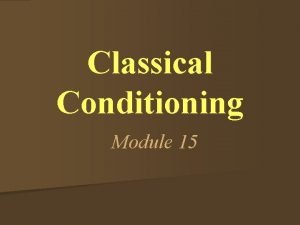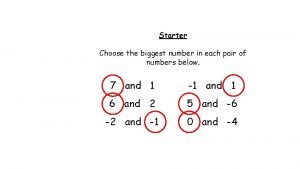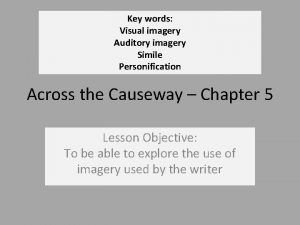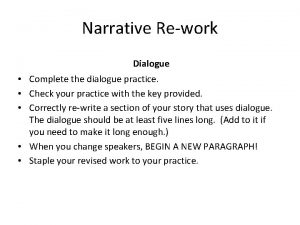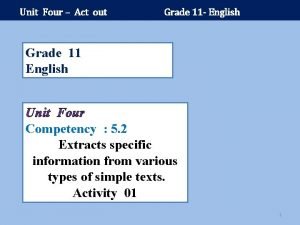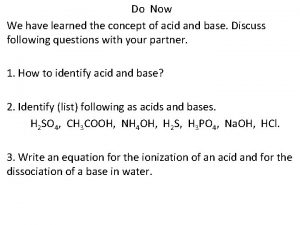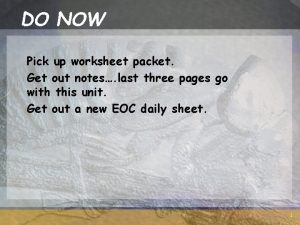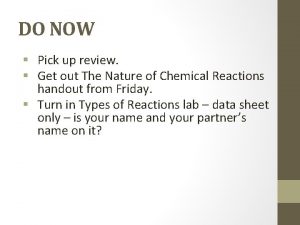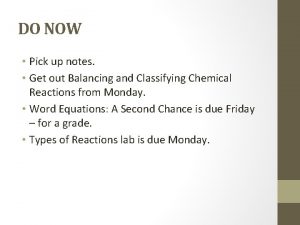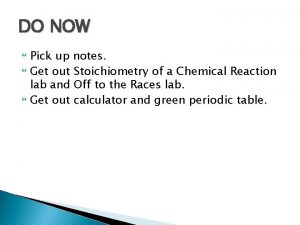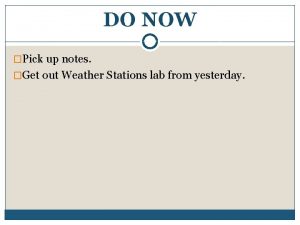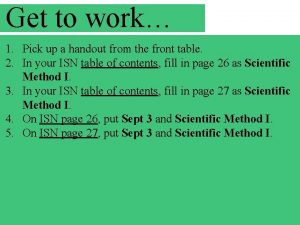DO NOW Pick up handout Get out Concept




















- Slides: 20

DO NOW • Pick up handout. • Get out Concept Review handout.

Types of Chemical Reactions • There are five basic types of chemical reactions. • Not all reactions will take these five forms. • Other classes of reactions can include. • net ionic • oxidation-reduction • neutralization

SYNTHESIS Reaction • sometimes called Combination • two or more simple substances combine to form a new, more complex substance. • What to look for: one product Examples: 2 Mg (s) + O 2 (g) 2 Mg. O (s) 4 Fe (s) + 3 O 2 (g) 2 Fe 2 O 3 (s) metal corrosion due to oxidation

SYNTHESIS Reaction

DECOMPOSITION Reaction • a complex substance breaks down into two or more simpler substances. • What to look for: one reactant H 2 SO 4 Ex. H 2 CO 3(aq) H 2 O(l) + CO 2(g) carbonic acid 2 H 2 O 2(aq) I- hydrogen peroxide water and carbon dioxide 2 H 2 O(l) + O 2 water and oxygen gas

DECOMPOSITION Reaction

COMBUSTION reaction • When compounds react with oxygen. • What to look for: a compound and oxygen which should yield two compounds, usually carbon dioxide and water. Example: Hydrocarbon + O 2 water + carbon dioxide CH 4 (g) + 2 O 2 (g) CO 2 (g) + 2 H 2 O (g)


SINGLE REPLACEMENT Rxn • Also called single displacement reaction. • one element replaces another element in a compound. • Use the activity series of metals to determine if the metal can be replaced or not. • What to look for: uncombined elements on both sides of the arrow

SINGLE REPLACEMENT Rxn

ACTIVITY SERIES


SINGLE REPLACEMENT A. An active metal will displace the metallic ion in a compound of a less active metal or the hydrogen in water or an acid. Need to look at activity series. EX. Cu (s) + Ag. NO 3 (aq) Cu(NO 3) 2 (aq) + Ag (s) EX. Mg (s) + 2 HCl (aq) Mg. Cl 2 (aq) + H 2 (g) 2 Na (s) + 2 H 2 O (l) 2 Na. OH (aq) + H 2 (g)

SINGLE REPLACEMENT B. Halogens (active nonmetals) will displace less active halogens. Fluorine is the most reactive, iodine is the least. EX. Cl 2 (g) + 2 Na. Br (aq) 2 Na. Cl (aq) + Br 2 (g)


DOUBLE REPLACEMENT Rxn • Also called double displacement reaction • different atoms in two different compounds replace each other. • two compounds react to form two new compounds – either a gas, precipitate, or water • What to look for: two compounds on each side Ex. HCl (aq) + Na. OH (aq) Na. Cl (aq) + H 2 O (l) Na. Cl (aq) + Ag. NO 3 (aq) 2 Na. NO 3 (aq) + Ag. Cl (s)

DOUBLE REPLACEMENT Rxn

PRACTICE 1. Br 2 + Na. I Na. Br + I 2 2. SO 3 + H 2 O H 2 SO 4 3. Zn + HCl Zn. Cl 2 + H 2 4. Ga 2 O 3 Ga + O 2 5. H 2 O 2 H 2 O + O 2 6. Ba(NO 3) 2 + Na 2 SO 4 Ba. SO 4 + Na. NO 3 7. P 2 O 5 + Ba. O Ba 3(PO 4) 2 8. C 4 H 8 + O 2 CO 2 + H 2 O 9. Pd. Cl 2 + HNO 3 Pd(NO 3)2 + HCl 10. C 2 H 6 + O 2 CO 2 + H 2 O

PRACTICE ANSWERS 1. 2. 3. 4. 5. 6. Single replacement Synthesis Single replacement Decomposition Double replacement 7. Synthesis 8. Combustion 9. Double replacement 10. Combustion Br 2 + Na. I Na. Br + I 2 SO 3 + H 2 O H 2 SO 4 Zn + HCl Zn. Cl 2 + H 2 Ga 2 O 3 Ga + O 2 H 2 O + O 2 Ba(NO 3) 2 + Na 2 SO 4 Ba. SO 4 + Na. NO 3 P 2 O 5 + Ba. O Ba 3(PO 4) 2 C 4 H 8 + O 2 CO 2 + H 2 O Pd. Cl 2 + HNO 3 Pd(NO 3)2 + HCl C 2 H 6 + O 2 CO 2 + H 2 O

TO DO • Balancing and Classifying Chemical Equations – due tomorrow.
 Shot me out of the sky you're my kryptonite
Shot me out of the sky you're my kryptonite Get on get off get in get out
Get on get off get in get out Handout 15-2 classical conditioning concept web
Handout 15-2 classical conditioning concept web Find odd one out
Find odd one out Solving linear inequalities hangman
Solving linear inequalities hangman Pick out an auditory image from the lines?
Pick out an auditory image from the lines? Raghav has been staying in the society for 7 years
Raghav has been staying in the society for 7 years Now i see it now you don't
Now i see it now you don't Hooray cheered gilda. does that mean we can stay
Hooray cheered gilda. does that mean we can stay All star somebody once told me
All star somebody once told me Confirm your email now and get 5 minutes as a gift!
Confirm your email now and get 5 minutes as a gift! Get up get moving quiz
Get up get moving quiz Get up get moving quiz
Get up get moving quiz Get up get moving
Get up get moving Repetition in pseudocode
Repetition in pseudocode Get focused get results
Get focused get results Germer
Germer Act out a dialogue
Act out a dialogue The rugged cross my salvation
The rugged cross my salvation Neutralization formula
Neutralization formula Rolling with resistance definition
Rolling with resistance definition


